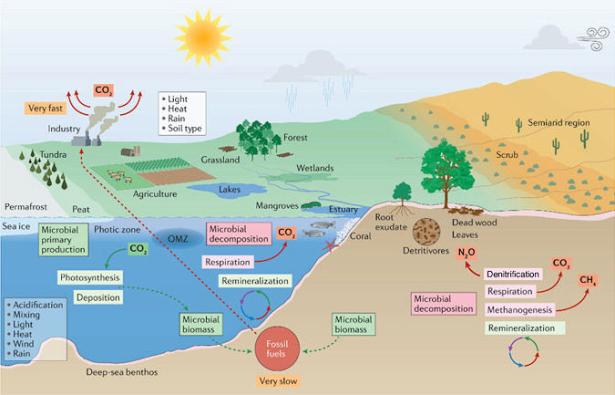Sunday Science: Microbes Drove Methane Growth Between 2020 and 2022, Not Fossil Fuels
"Understanding where the methane is coming from helps us guide effective mitigation strategies," said Sylvia Michel, a senior research assistant at the Institute of Arctic and Alpine Research(INSTAAR) and a doctoral student in the Department of Atmospheric and Oceanic Sciences at CU Boulder. "We need to know more about those emissions to understand what kind of climate future to expect."
Methane is a potent greenhouse gas responsible for about a third of the planet's warming since industrialization. Although the atmosphere contains less methane than carbon dioxide, methane traps about 30 times more heat than carbon dioxide over a 100-year time frame, making it a critical target for addressing climate change.
"Methane concentrations in the air have almost tripled since the 1700s," said co-author Jianghanyang (Ben) Li, an assistant professor in the Department of Atmospheric and Oceanic Sciences and INSTAAR.
But unlike CO2, which can stay in the atmosphere for thousands of years, methane degrades within a decade. As a result, addressing methane emissions can have an immediate and powerful impact in slowing the rate of warming, making it a "low-hanging fruit," Li said.
While the finding suggests microbes have been emitting more methane than fossil fuels in recent years, reducing fossil fuel consumption remains key to addressing climate change, the team said. Cutting down food waste and consuming less red meat can also help lower one's methane footprint.
ID the source
Previous research suggests fossil fuel production is responsible for about 30% of global methane emissions.
But microbial sources -- such as wetlands, cattle and landfills -- are an even more significant source of methane, accounting for more than half of global emissions. Archaea, a type of microorganism living in soil and the guts of cows, produce methane as a byproduct of breaking down organic matter.
Michel and Li have been working with Boulder's Global Monitoring Laboratory (GML) at the National Oceanic and Atmospheric Administration (NOAA) over the past years.
The lab receives air samples from 22 sites around the world every week or two. Researchers then isolate different components of the air -- such as CO2 or methane -- for analysis. By examining the types of carbon atoms, or isotopes, that the methane sample contains, Michel, Li and the team can identify its source. For example, methane from fossil fuels has more carbon-13 isotope than methane in the air, and methane from microbial sources contains even less carbon-13. The lab has been measuring isotopes of methane since 1998.
Scientists have observed a rapid increase in atmospheric methane levels since 2007, following a period of stabilization in the early 21st century. In 2020, NOAA reported the highest growth rate of methane since it began collecting data in 1983, and that record was shattered again in 2021.
At the same time, Michel noticed a surprising decrease in the carbon-13 isotope over the past 17 years. She and the team set out to understand what was driving it.
The culprit
Using computer simulations, Michel and her team modeled three different emissions scenarios to see which one would leave an isotopic signature similar to the one observed.
They found that between 2020 and 2022, the drastic increase in atmospheric methane was driven almost entirely by microbial sources. Since 2007, scientists have observed microbes playing a significant role in methane emissions, but their contribution has surged to over 90% starting in 2020.
"Some prior studies have suggested that human activities, especially fossil fuels, were the primary source of methane growth in recent years," said Xin (Lindsay) Lan, a scientist at the Cooperative Institute for Research in Environmental Sciences (CIRES) at CU Boulder and NOAA. She leads the reporting on NOAA's global greenhouse gas trends at the GML. "These studies failed to look at the isotope profile of methane, which could lead to a different conclusion and an incomplete picture of global methane emissions."
It remains unclear whether the increased microbial emissions came from natural sources like wetlands or human-driven sources, such as landfills and agriculture. The team plans to delve deeper to identify the exact source of methane.
"In a warming world, it wouldn't be surprising if any of these sources emitted more methane," said Michel, who explained that microbes, like humans, tend to have higher metabolism when it's warm. "Consequently, more methane could stay in the atmosphere to accelerate global warming. So we need to address the climate crisis, and that really means addressing CO2 emissions."
Materials provided by University of Colorado at Boulder. Original written by Yvaine Ye. Note: Content may be edited for style and length.
Journal Reference:
Sylvia Englund Michel, Xin Lan, John Miller, Pieter Tans, J. Reid Clark, Hinrich Schaefer, Peter Sperlich, Gordon Brailsford, Shinji Morimoto, Heiko Moossen, Jianghanyang Li. Rapid shift in methane carbon isotopes suggests microbial emissions drove record high atmospheric methane growth in 2020–2022. Proceedings of the National Academy of Sciences, 2024; 121 (44) DOI: 10.1073/pnas.2411212121
Stay informed with ScienceDaily's free email newsletter, updated daily and weekly. Or view our many newsfeeds in your RSS reader:

Our Bigger Brains Came With a Downside: Faster Aging
By Carl Zimmer
New York Times
A study comparing chimpanzee and human brains suggests that the regions that grew the most during human evolution are the most susceptible to aging.
August 28, 2024


Spread the word